The T-Mobile G2 Preview
by Vivek Gowri on October 7, 2010 12:29 PM ESTOh yes, and now we get to the real stuff. Benchmarks! Let’s start with the CPU benchmarks to see how the 800 MHz 2nd gen Snapdragon matches up with the older 1 GHz parts. All of them implement the same Scorpion architecture, except that the MSM7230 is manufactured on a 45nm process as opposed to 65nm for the QSD8x50. Simple colour coding scheme going on in the graphs here: red for the G2, green for the 1st generation Snapdragon phones, blue for anything running TI OMAP 3 underhood, gold for the Hummingbird Galaxy S devices, black for the iPhone 4, and purple for the Marvell PXA930-running BlackBerry Torch.
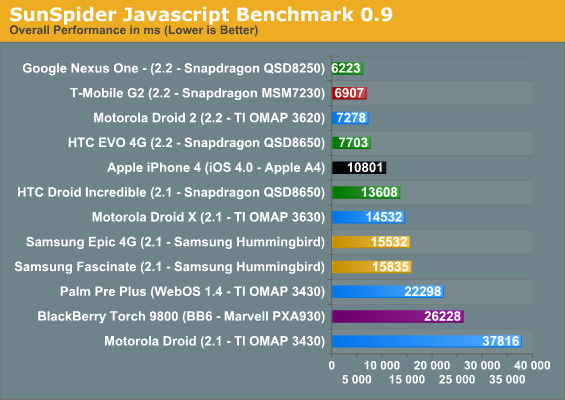
The SunSpider Javascript benchmark is very quick on the G2. While the Froyo Nexus One remains the fastest on most of these benchmarks, the G2 is definitely getting there, probably due to the untouched Android build it’s running. So even with a slower clockspeed, the G2 has a better score on the JS benchmark than the NinjaBlur-equipped Droid 2 and the Sense UI-equipped EVO 4G.
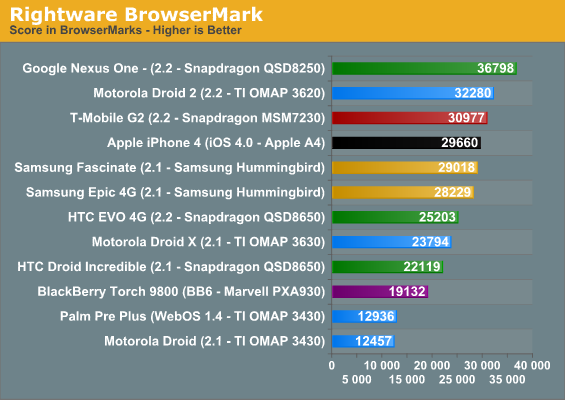
Rightware’s BrowserMark puts the G2 right between the Droid 2, the Fascinate, and the iPhone 4, and about 20% slower than the Nexus One. Given the 20% reduction in clock speed, this is pretty understandable.
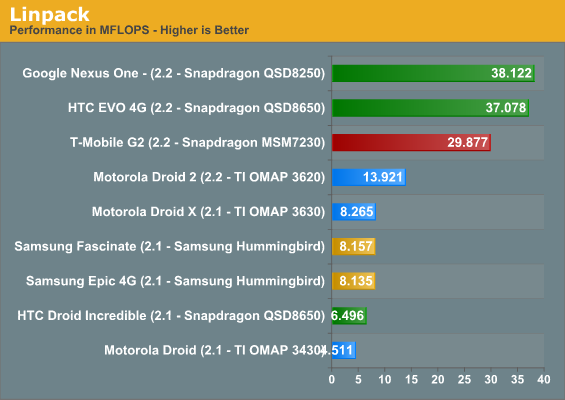
The G2’s Linpack score is about 25% lower than the Nexus One and EVO 4G, but significantly higher than the Droid 2’s score, potentially due to the higher throughput SIMD FP units in Qualcomm's CPU.
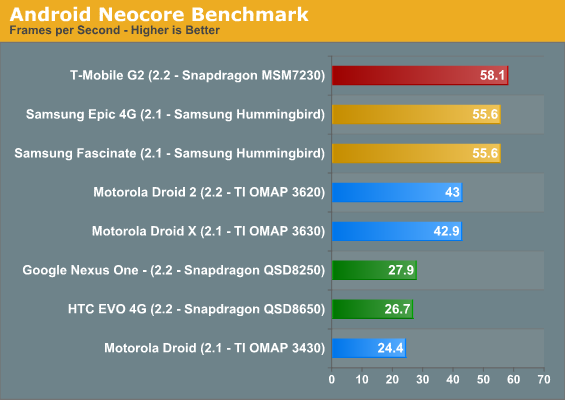
But the really interesting benchmarks are the graphics benchmarks. We’ll start with Neocore, which is Qualcomm’s benchmark to show off the capabilities of the Adreno GPU.
The score is quite good, at more than double the Nexus One’s. The benchmark is capped at roughly 60 fps which is why we see no real difference between the Adreno 205 and the PowerVR SGX 540. For a measurable performance difference we turn to our old favorite: Quake 3.
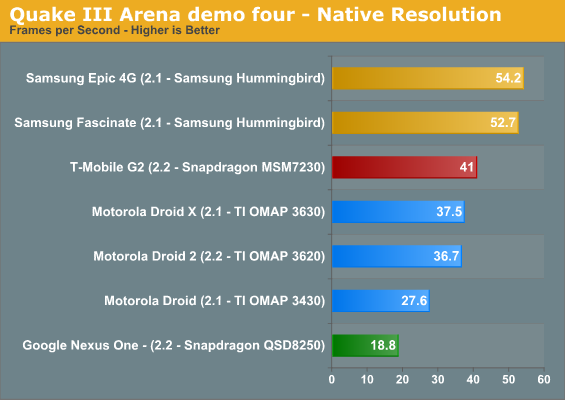
In a neutral gaming benchmark like the Quake III Arena demo, we can really get a feel for how fast Adreno 205 is. And though nothing on the market can touch the SGX 540, the Adreno 205 basically runs rings around the Adreno 200 in the EVO and Nexus One and even outpaces the SGX 530 in the Droid 2 and Droid X. So while the Adreno 205 isn’t world beating, it brings about a huge change by making the the 2nd generation Snapdragon SoC competitive as far as GPU performance goes. Qualcomm no longer comes with a GPU performance tradeoff.
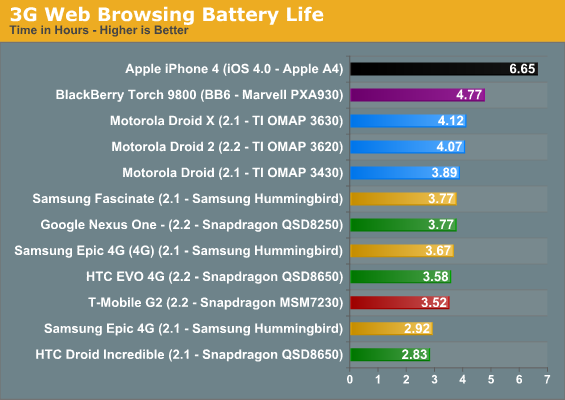
The G2 comes with a pretty small battery, a removable 4.81 Wh (1300 mAh) Li-ion affair that can be easily accessed and replaced. The Nexus One came with a 5.18 Wh battery, the Droid 2 had 5.2 Wh capacity on tap, the Droid X had a 5.6 Wh unit, and the EVO used a 5.5 Wh battery. So naturally, with a lower capacity battery, the G2 comes with less battery runtime too. Thus far we’ve only had the time to run the 3G web browsing battery life test, and the G2 is way down at the very bottom of our charts, matching the Palm Pre Plus in battery life (which has a 1150 mAh battery). It’s not too bad, it’s on par with the Nexus One for minutes-per-Wh efficiency, but 3.5 hours of 3G web browsing is still not very good.
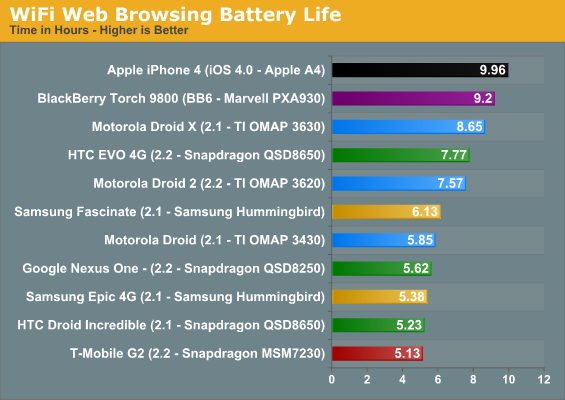
Update: We're adding battery life tests as we go, so here's the WiFi browsing test. Again, it's almost at the bottom, again it's about on par with the Nexus One on an efficiency level. It's a small battery, so when compared to phones that have 10-20% more battery capacity, it does look quite poor. What does seem to be consistent though is that the OMAP 3 phones are more power efficient, even on a per-Wh basis.

But given the 3G speeds the G2 is pulling, maybe we should give it a pass. T-Mobile's HSPA+ network is FAST, even in areas of Seattle that have rather poor signal coverage. On average, I'm pulling around 5.5 Mbps downstream and anywhere between 1 and 1.5 Mbps upstream. Interestingly, this is signifcantly faster than the speeds I saw out of Sprint's WiMAX 4G network on the EVO when I had it in June. While I can't vouch for areas that don't have T-Mobile's HSPA+ network enabled yet, the areas that do should see the G2 fly. It's T-Mobile's first HSPA+ device, so it should be able to utilise the full potential of the faster network.










59 Comments
View All Comments
Ambictus - Thursday, October 7, 2010 - link
"the first HTC GSM Android device (since the Nexus One)"Actually the HTC Aria was released in June on AT&T.
ImSpartacus - Thursday, October 7, 2010 - link
I think we are to assume that such statements are limited to tier 1 phones. In if it doesn't cost $200, it doesn't count.Good catch though, I'm sure Gowri will respond with a proper answer soon.
VivekGowri - Thursday, October 7, 2010 - link
Good catch, I completely forgot about the Aria. Nothing against it, it's a nice little phone, but it's not a real high end Android device (which is what I was thinking about when I wrote that). ImSpartacus was right, I was basically just looking at the so-called "superphones".Goi - Wednesday, October 20, 2010 - link
Then there's also the HTC Desire...SDentertainmnt - Thursday, October 7, 2010 - link
"As the first GSM Android device with a keyboard (since the G1)"I Believe the Tmobile MyTouch Slide fits that description and has been out for months now :)
VivekGowri - Thursday, October 7, 2010 - link
I just got owned. Thanks for catching my mistakes you guys! :)vol7ron - Thursday, October 7, 2010 - link
You could replace the phrase, "the first device since..." with, "since ... there haven't been too many other (if any) devices that..." and fix all your mistakes in one swoop :)ImSpartacus - Thursday, October 7, 2010 - link
When the Engadgets of the world are all posting their G2 REviews, AT is posting its PREview.I <3 Anandtech's thoroughness.
mino - Thursday, October 7, 2010 - link
Actually, considering that the mass-produced units may have a bunch of the issues taken care of there is nothing wrong about it.Not forgetting that an AT "Preview" usually has about as much useful data in as an Average "Review" ... It is not hard to churn out 20 pages of spin.
To me it seems a limited amount of AT man-hours along with probable-to-be-corrected-soon type of device is the reason.
vol7ron - Thursday, October 7, 2010 - link
I think he was saying that AT takes the time to do the reviews right?